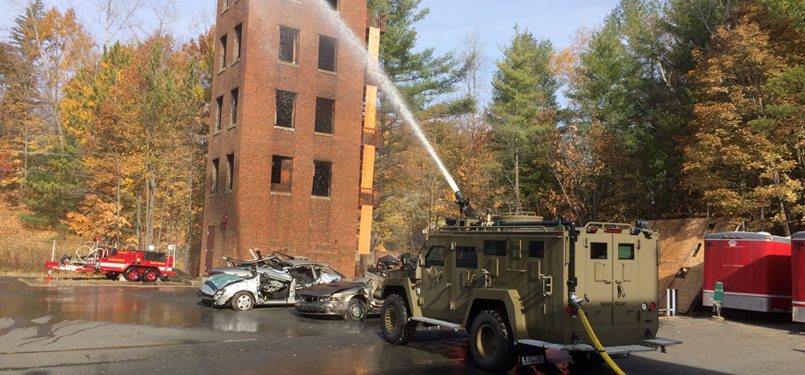Lenco’s new water monitor provides a tactical advantage in dangerous situations
By PoliceOne BrandFocus Staff
View Full Article on PoliceOne.com
The Lenco BearCat has long been a must-have for many SWAT teams around the country. The armored vehicle is a multi-purpose tool, providing armor, transportation and a force multiplying effect that can generally make a situation less dangerous for the SWAT members involved.
As the needs of tactical teams change, so too must the BearCat. SWAT teams are often called out to situations where other first responders, such as firefighters and EMTs, are also in danger. Unfortunately, the reality is that these types of ambushes are more and more common, and SWAT teams need an answer to them.
The next evolution of the BearCat
Lenco’s answer to real-life situations like these is the new BearCat water nozzle. This water monitor, mounted on the roof of the BearCat connects to a pumper truck. Once connected, the stream is controlled from the nozzle on the BearCat by operating a joystick mounted inside the vehicle.
This means that the fire can be put out from an armored and protected position, minimizing the risk to human life. This is critical in active shooter situations, where it’s not safe for the firefighters to be battling the blaze. Some departments have already adopted the add-on, like the Kernersville, North Carolina Police Department. Lieutenant Tim Summers of the Kernesville PD said, “with the fire department’s assistance, hooking to the BearCat with the monitor, we can extinguish or suppress the fire until the situation is safe for fire personnel to come in and do their job.”
Making the case: 3 real-life scenarios
The value of the water nozzle is in how it can be applied to scenarios that tactical teams across the country are currently facing. Here are three such scenarios that demonstrate the capabilities the nozzle provides to resolve the situation:
1. Barricaded suspect lights his house on fire
Unfortunately, an all-too-common scenario revolves around a suspect who barricades himself in a structure and lights it on fire, intentionally or not. This presents real issues for cross-agency collaboration. The fire department needs the protection of law enforcement to put out the fire, but police need the fire put out to resolve the situation.
Take this actual scenario: 53-year-old Kyle Johnson shoots a neighbor in rural Le Roy, New York, then barricades himself in his own home and sets it on fire. When firefighters come to put out the blaze, he opens fire on them. It’s a nightmare scenario anytime you have first responders being fired on, especially when they are there to put out a raging fire. Forced away by the gunfire, the firefighters pulled back to a safe distance and awaited SWAT.
Luckily, this situation ended with the suspect in custody and the firefighters safe, but it could very well have gone the other way. Having a BearCat available that could put out the fire safely from behind its armor would have been a valuable resource.
2. Use of less-lethal devices accidentally starting a fire
Barricade situations are volatile by their very nature. Sometimes, things can go awry in a SWAT standoff situation. In times where the deployment of chemical agents or other less-lethal means accidentally start a fire, SWAT needs the capability to put those fires out. The water nozzle on the BearCat would provide this capability.
3. Firefighter ambush
Perhaps the most alarming scenario on this list is a firefighter ambush. A growing number of cases over the past few years involve suspects creating fires, waiting for first responders to arrive, and then opening fire.
One such event, in 2012, started as a house fire in Webster, New York. William Spengler, a 62-year-old ex-con, set his car and home on fire. He waited for the fire department to respond and opened fire on them when they arrived. Firefighters were unable to fight the fire and had to let the blaze burn for hours while the situation was resolved. All told, four firefighters were shot, two were killed, and the suspect shot himself at the scene.
Being able to leverage the armor of the BearCat to put out the fire while keeping firefighters out of harm’s way could have saved two lives in that situation.
Such scenarios are not unique or isolated events. The capability of tactical teams to deal with a fire threat in a live situation will become increasingly important. The water nozzle attachment to the BearCat represents a step forward in addressing such threats, and ultimately, in protecting the lives of first responders and civilians caught in the line of fire.


